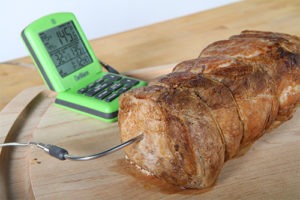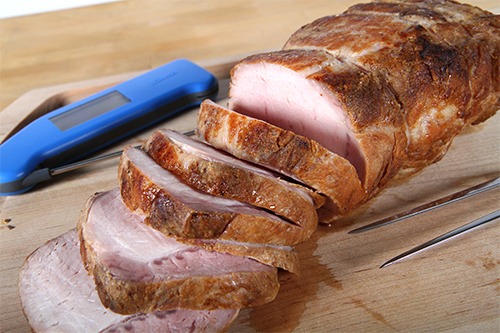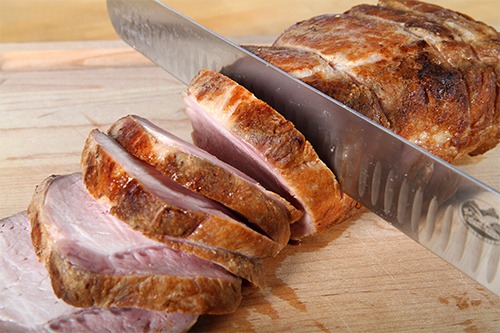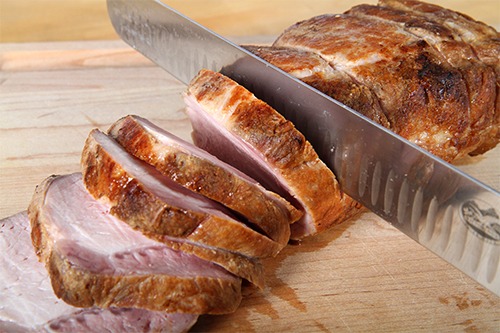Put These Chef-Recommended Pork Temps to the Test
In recent years, advances in both food safety and nutritional content of pork has prompted the USDA to revisit their recommended pork temperatures. As pork producers improved feeding and breeding practices (in accordance with industry-wide efforts covering food safety), the Department of Agriculture decided it was time to make a change.
[Tweet “Advances in both food safety and nutritional content of pork has prompted the USDA to revisit their recommended pork temperatures.”]
There is, perhaps, no one more in agreement with the changes in pork guidelines than the world-renowned meat expert, Bruce Aidells. Aidells says, “It (USDA) has finally agreed with those of us who write recipes and tell our readers to cook pork to a much lower temperature.”
The USDA now recommends cooking pork (whole muscle cuts such as loins, roast and chops) to a minimum internal temp of 145°F – a full 15° lower than what was previously recommended. Aidells says, “This is a vast improvement over the old recommendation, and the results will be more palatable.” It should be noted however, that ground pork, like all ground meat, should be cooked to 160°F.
In his book, The Great Meat Cookbook, Aidells provides pork doneness charts based on what he believes will give at-home cooks the best results. While a quick glance at Aidells’ chart may have readers wondering why his temps are slightly lower than what the USDA recommends, he assures us that when using dry-heat cooking methods, carry-over heat will put the internal temp right where it needs to be. Of course, Aidells says, “…carry-over heat will vary depending on the size of the piece of meat and the intensity of the heat source, consult the individual recipes to determine exactly what internal temperature the meat should be when removed from the heat source, and follow the resting times given in the recipes.”
Regardless of what a recipes says however, Aidells cautions those who are immunologically compromised or pregnant to cook pork to 160°F, as recommended by the USDA.
Aidells calls medium (140 to 145°F) the ideal range for lean pork tenderloin, loin cuts and leg roasts. The end result promises to be tender, juicy and most important – safe to eat. If you’re concerned about the lower-than-recommended internal temperature, Aidells reminds us that, “…if you’re worried about trichinosis, fear not: The spores are killed when pork reaches 138°F and is held there for just a few minutes.”
This is where using a super-accurate thermometer, like the Thermapen®, is of the utmost importance. If your thermometer is off by several degrees it’s very easy to cook right past medium on to medium-well and well done, inadvertently ruining an expensive piece of meat. On the other hand, an inaccurate thermometer can have you believing you’ve reached a food safe temp to kill trichinosis (137°F), when in actuality you’re several degree below the target temp.
Well-marbled loin cuts from heirloom pork, such as blade end of the loin can be cooked to higher temps to help render fat. Aidells suggests cooking these cuts medium-well (150 to 155°F). He says, “The meat will usually be almost uniformly gray, with a pinkish tint near the bone.”
Aidells identifies other cuts that should be cooked to higher temps (165 to 170°F). Spareribs and Boston butts are two examples that are suitable for moist-heat cooking to higher than recommended internal temps. He doesn’t recommend cooking to this degree of doneness for lean pork unless it has been flavor-brined. For more information on meats that require higher temps read, “Some BBQ Meats Must Be Cooked to Higher Temps.”
Grill-Roasted Pork Loin
There really is no better way to put the new USDA pork temps to the test than with a tried and tested recipe from the folks at America’s Test Kitchen. Their Grill-Roasted Pork Loin is the perfect center piece for any family gathering and is especially perfect during a holiday celebration. This recipe is taken from the pages of Cook’s Illustrated’s Meat Book.
1 – Dissolve 1/4 cup of salt in 2 quarts cold water in a large container. Submerge pork loin into brine, cover and refrigerate for 1 to 1.5 hours. Cook’s recommends using the blade-end roast for this recipe because the fatty pockets that separate the different muscles add moisture and flavor. Of course any loin can be used. Be mindful of what kind of loin you’re using because your pull times will vary depending on the amount of fat on the loin.
Aidells suggests pulling leaner meats off the heat at 135 to 140°F and letting the residual heat carry the internal temp to 145 to 150°F. However, if you’re cooking a fattier loin – like the blade loin recommended by Cook’s – Aidells suggests pulling it off the heat a little later (145 to 150°F) so the fat has a chance to render.
2 – Remove the loin from the brine, pat dry and rub with oil and coat with pepper. Let it temper at room temp for 1 hour.
3 – Build a “two-level” fire in your grill. Set up one side with hot coals for searing and leave the other side devoid of coals for indirect roasting. For this recipe, you’ll sear the roast over the hot coals and finish roasting over indirect heat.
If cooking on a gas grill, preheat grill with all burners on. With grill preheated, leave primary burner on and turn off remaining burners. Sear over primary burner (set to high) and roast over cool the cooler side of the grill. Adjust primary burner to maintain a temp of 300 to 325°F to finish cooking to the ideal internal temp.
4– Clean and oil cooking grate. Place pork loin on hotter side of grill, fat side up (cover if using gas), and cook until well browned on all sides, 10 to 12 minutes, turning as needed. Move to cooler side of the grill, positioning roast parallel with and as close as possible to the heat. Cover and cook for 20 minutes.
5 – Rotate roast 180 degrees, cover and continue to cook until meat registers 145 degrees. A leave-in probe thermometer with an alarm, like the ChefAlarm, is the ideal tool for this application. With a probe placed as near the center of the roast as possible monitor the internal temperature without having to open the lid on the grill. Set the alarm to sound when you’ve reached your ideal internal temperature and there will be no guessing as to whether the roast is finished cooking.

________________________________________________
Comment below and Share these Pork Temperature Tips for a chance to win a copy of Bruce Aidells’ Great Meat Cookbook. Winner will be selected Sunday, March 22nd. Closed! Winner: Audra





A pork LOIN is NOT a pork TENDERLOIN.
Why I didn’t purchase one of these gems years ago remains one of the mysteries of life. There is nothing quite like it on the market for accuracy and ease of use. One thoroughly satisfied customer.
This cookbook sounds like something I could really use.
The lower temps work great for a nice juicy loin. I have been using them for awhile now. The two level fire also works well thought I acco it differing my Komodo Kamado. I also use it for a nice juicy thick steak.
Hi Roy…how do you like your Komodo? I’ve been considering the XL for my new smoker…
Gaylord, I have had my Primo XL (Kamado smoker) for almost a year now and I love it. It was expensive but I think it’s worth it. And it’s made in the U.S.! That’s important to me. I will say that it is a different cooking style and I’m still working on mastering temperature control but, according to others, I have nailed the pork shoulder!
This makes good sense to me.. chas..
Even better, brine the loin or pork chops in 5% salt in apple cider for 2 hours, rinse for 15 seconds under running water and cook per the article. The Chef Alarm with high temperature tolerant probe means getting it done right the first time and every time. Leaving the probe in with the lid down means less heat loss, faster grilling and cooking to perfection. Brining chops make sure the entire chop is in contact with the solution.
great tips, but I think one thing is for uncertainty. the meat in the photos look more like a pork loin, not tenderloin which is thinner and narrower. about half the size of a loin but the length can be the same.
anyway, I’ve smoked both to 145+ degrees and they always turn out great.
smoke on!
Hi Mark – You’re right! The pork in the photos is a pork loin, not a tenderloin. We cooked our to 135°F and let it rest. The internal temp crept up to 144°F. Perfect?
Whenever I make a pork loin my roast must have some fat on it. This helps my pork add flavor over all. I cook my roast in 2-3 inches of water at 325°. This makes my pork after 2-3 the most juicy and nice flavor.
You are correct! The pork shown in the pics is a loin cut, not a tenderloin. As you know, a tenderloin is smaller than the loin roast.
it’s hard convincing guests when they see pork slightly pink in the center. they freak out . almost everyone believes the old myth abt pork being totally white when finished. sad because 145 is the only temp to have. the pork is tender, juicy, and incredible.
I could really use this cookbook. I hope more people learn the new temps and realize pork that is cooked with pink inside is perfectly safe and so much tastier.
I find that a dry rub works on pork as well as brine and is a lot simpler. I also like to inject it with an apple juice and flavouring mixture. Garlic is a must for us, juniper is nice, the list goes on and on.
Pork loin or tenderloin, even with brining, can’t beat the moistness and tenderness you get from a Boston Butt or shoulder roast. But no matter your preference, there is no question I get better results by using my chef alarm thermometer while slowly roasting with indirect heat at low temperature.